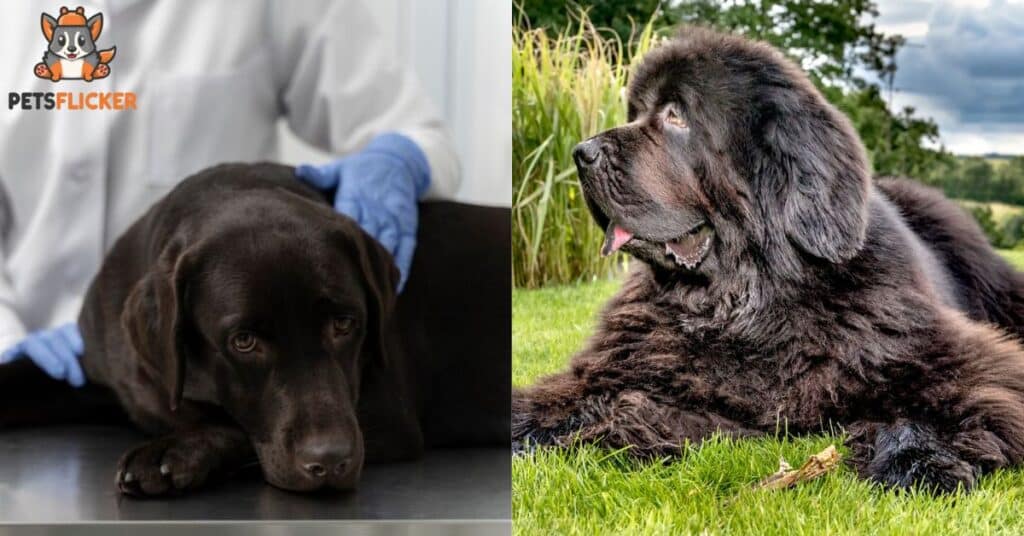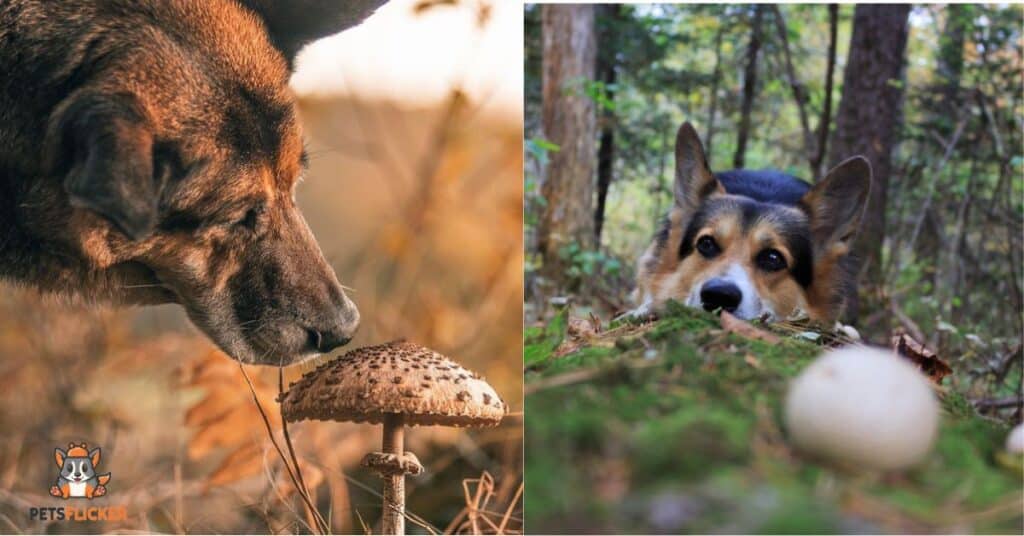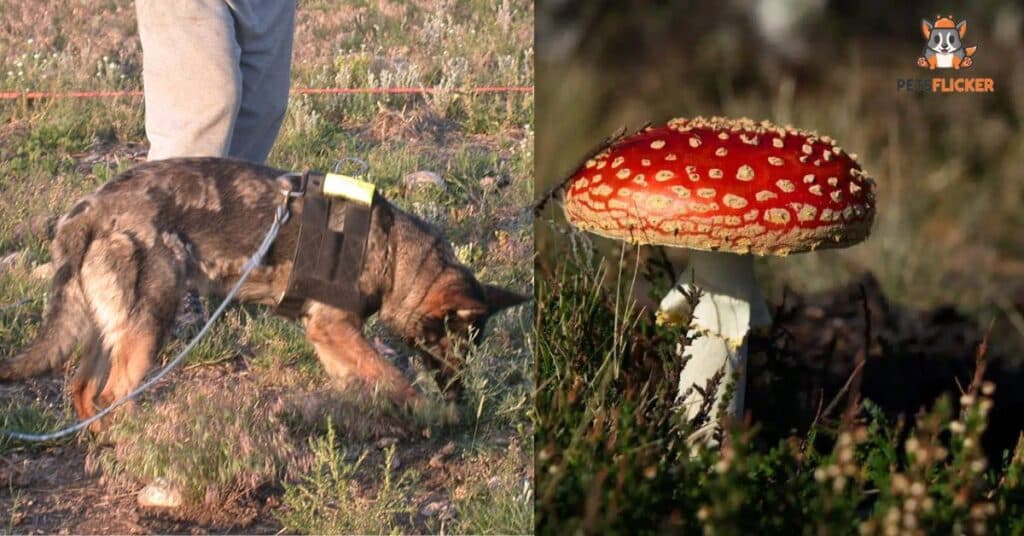Mushrooms are fungi that grow above ground, often with a stalk and cap. They come in various shapes, sizes, and colors, and can be edible or poisonous. Mushrooms are commonly used in cooking for their unique flavors and textures.
Drug dogs are trained to detect certain substances, but can they smell mushrooms? While these highly skilled animals are adept at detecting drugs like marijuana, cocaine, and heroin, their ability to detect mushrooms is limited.
Due to the differences in scent profiles between drugs and mushrooms, drug dogs may not reliably detect the latter. Can drug dogs smell mushrooms? The answer is not as straightforward as it is for other substances.
What Are Drug Dogs?

Drug dogs, also known as narcotics detection dogs, are specially trained canines employed by law enforcement agencies to detect the presence of illicit drugs such as cocaine, heroin, and marijuana. These highly skilled animals have a keen sense of smell, allowing them to identify even trace amounts of drugs in various environments.
Using their exceptional olfactory abilities, drug dogs assist authorities in locating hidden narcotics during searches at airports, border crossings, and other checkpoints. Through rigorous training, these dogs learn to recognize specific drug odors, making them invaluable assets in combating drug trafficking and keeping communities safe.
Can Drug Dogs Smell Mushrooms?
Drug dogs are trained to detect various illicit substances, but their ability to smell mushrooms depends on their specific training. While some drug dogs may be trained to detect certain types of mushrooms containing psychoactive compounds like psilocybin, not all drug dogs are trained for this purpose.
The effectiveness of drug dogs in detecting mushrooms also depends on factors such as the strain of mushroom, its potency, and the training protocols followed by law enforcement agencies. However, it’s essential to note that drug dogs primarily focus on detecting substances such as cocaine, heroin, and marijuana, and may not consistently identify mushrooms during routine searches.
Can Dogs Eat Mushrooms

Dogs should avoid eating mushrooms from the wild as many varieties can be toxic to them, causing symptoms ranging from gastrointestinal upset to organ failure. It’s safest to stick to commercially cultivated mushrooms that are safe for canine consumption, such as plain white or cremini mushrooms.
While some types of mushrooms are safe for dogs in small quantities, it’s best to consult with a veterinarian before introducing them into your pet’s diet to ensure they don’t have any adverse reactions or underlying health conditions.
Penis Envy Mushrooms
Dogs, like pets, may inadvertently consume mushrooms, including the toxic Penis Envy variety, outdoors. Owners should learn to recognize these mushrooms to prevent accidental ingestion and protect their furry friends.
Penis Envy mushrooms contain harmful compounds that can induce vomiting, diarrhea, seizures, and organ failure in dogs, necessitating prompt veterinary care for ingestion cases.
Psilocybin Mushrooms
Psilocybin mushrooms are fungi that contain a substance called psilocybin, which can cause hallucinations and altered perceptions when ingested by humans. It’s crucial to keep these mushrooms away from dogs, as they can be toxic and potentially harmful to our furry companions if consumed.
Chanterelle Mushrooms
Chanterelle mushrooms are a type of edible fungus known for their golden color and delicate flavor.
It’s important to note that dogs should not consume chanterelle mushrooms as they can cause gastrointestinal upset and other adverse reactions. Keep these mushrooms out of reach from your furry friends to ensure their safety and well-being.
How are Drug Sniffing Dogs Trained to Smell Mushrooms?
Drug sniffing dogs are trained to detect mushrooms containing psychoactive compounds like psilocybin through a process called imprinting. During training, handlers use samples of mushrooms to familiarize the dogs with the scent, rewarding them when they correctly identify it.
Handlers employ positive reinforcement techniques, such as treats or playtime, to reinforce the association between the scent of mushrooms and a reward. Through repetition and consistent training, drug sniffing dogs learn to recognize the unique odor of mushrooms and indicate their presence to their handlers.
Associating Smell with a Favorite Toy
Associating smell with a favorite toy is a common technique used in dog training. Dogs have a powerful sense of smell, and they can quickly learn to link scents with positive experiences.
By introducing a specific scent alongside a favorite toy during playtime or training sessions, dogs begin to associate that smell with the joy and excitement of playing with their beloved toy. Over time, this association strengthens, making it easier for trainers to use scents to communicate with their dogs and reinforce desired behaviors.
Gradual Introduction of Target Scent
Gradual introduction of a target scent is a method often used in dog training. Trainers start by presenting the scent in small doses, allowing the dog to become familiar with it without overwhelming them.
As the dog becomes more accustomed to the scent, trainers gradually increase its intensity, reinforcing positive associations with treats or praise. This gradual approach helps dogs develop a strong recognition of the target scent and improves their ability to perform scent-related tasks effectively.
Scent Identification through Playtime
Scent identification through playtime is a fun and effective way to engage with your dog while honing their olfactory skills. During play, hide a scent-infused item, such as a cloth or toy, for your dog to find.
Encourage your dog to sniff out the hidden item by rewarding them with treats or praise when they successfully locate it. This playful activity not only strengthens your bond with your pet but also enhances their ability to identify and follow scents, providing mental stimulation and enrichment.
Training with Actual Drugs
Training with actual drugs involves using real samples of illicit substances during the training of drug detection dogs. These samples are securely stored and handled to ensure safety and legality throughout the training process.
By exposing the dogs to the actual scent of drugs, trainers can accurately simulate real-world detection scenarios, helping the dogs develop reliable detection skills. This hands-on approach is crucial for preparing drug detection dogs to effectively identify and alert their handlers to the presence of illegal substances in various environments.
Can Sniffer Dogs Smell All Mushrooms?
Sniffer dogs’ ability to detect mushrooms depends on their training and the specific type of mushroom. While some sniffer dogs may be trained to detect certain psychoactive mushrooms like those containing psilocybin, they may not recognize all varieties.
Factors such as the potency of the mushroom’s odor and the dog’s training play significant roles in their ability to detect mushrooms accurately. However, most sniffer dogs are primarily trained to detect illicit drugs like cocaine, heroin, and marijuana, and may not consistently identify mushrooms during routine searches.
What Can Drug Sniffer Dogs Not Smell?
Drug sniffer dogs have impressive olfactory abilities, but there are limitations to what they can detect. These dogs are primarily trained to detect specific narcotics such as cocaine, heroin, and marijuana.
However, drug sniffer dogs may struggle to detect certain synthetic drugs or substances with minimal odor, as well as substances that are well-concealed or masked by other scents. Additionally, their training focuses on identifying illegal drugs, so they may not be as effective in detecting legal substances or prescription medications.
Small qualities: Drug sniffer dogs’ expertise lies in detecting specific narcotics, yet they may struggle with substances in small quantities due to their training emphasis on larger amounts. This highlights the importance of thorough detection methods to ensure comprehensive screening.
Enclosed or Concealed Containers: Drug sniffer dogs may struggle to detect substances concealed in airtight or well-sealed containers due to their specialized training focusing on odor detection. Concealed substances present a challenge for these canines, underscoring the importance of thorough inspection techniques.
Non-Drug Odors: Drug sniffer dogs, despite their expertise, may struggle with detection when strong non-drug odors are present, potentially diverting their attention away from target scents. This highlights the importance of minimizing competing smells to enhance the effectiveness of their detection efforts.
New or Unfamiliar Substances: Drug sniffer dogs may struggle with new or unfamiliar substances not included in their training regimen, highlighting the importance of ongoing adaptation and training protocols. This underscores the need for comprehensive training to ensure effective detection of emerging substances.
Certain Types of Drugs: Drug sniffer dogs, adept at identifying narcotics like cocaine and marijuana, may struggle with synthetic drugs or those with subtle scents. Their training focuses on illegal substances, potentially hindering detection of certain types of drugs or medications.
Drugs Masked by Other Strong Odors: Drug sniffer dogs may struggle to detect drugs masked by potent odors, hindering their ability to accurately identify substances. This underscores the importance of minimizing competing scents during detection operations for optimal canine performance.
Can Drug Dogs Smell Edibles?

Drug dogs are trained to detect the scent of marijuana, including edibles infused with THC. However, their ability to detect edibles may vary depending on factors such as the potency of the edibles and the training of the individual dog.
The strong odor of marijuana present in many edibles can often be detected by drug dogs, allowing them to alert their handlers to the presence of these substances during searches or inspections.
FAQ’S
Are all mushrooms safe for dogs to eat?
No, some mushrooms can be toxic to dogs.
Can drug dogs smell marijuana-infused edibles?
Yes, they can detect the scent of marijuana in various forms, including edibles.
How do handlers train drug dogs to recognize the scent of mushrooms?
By using samples and positive reinforcement techniques.
What are the risks of dogs ingesting mushrooms?
Symptoms can range from gastrointestinal upset to organ failure.
Do drug dogs need specific training to detect mushrooms?
Yes, they require specialized training for mushroom detection.
Can dogs differentiate between edible and toxic mushrooms?
Not always, which is why it’s important to prevent them from ingesting wild mushrooms.
How can I prevent my dog from eating harmful mushrooms?
Keep your dog away from areas where wild mushrooms grow and supervise outdoor activities.
Conclusion
In conclusion, drug dogs play a crucial role in law enforcement, primarily trained to detect substances like cocaine, heroin, and marijuana. However, their ability to detect mushrooms, including those containing psychoactive compounds, varies depending on their specific training and the protocols followed by handlers.
Can drug dogs smell mushrooms? While some may be trained for it, their effectiveness in this regard may not be as reliable as their detection of traditional narcotics. Pet owners should remain vigilant to prevent accidental ingestion of mushrooms by their dogs, especially considering the potential risks associated with toxic varieties like the Penis Envy mushroom.

Elax is a seasoned writer with five years of experience specializing in articles focused on pets. His passion for animals and extensive knowledge shines through his engaging and informative writing style, captivating readers with insights into pet care and companionship. With a knack for crafting compelling content, Elax brings a wealth of expertise to the realm of pet-centric literature on your website.







